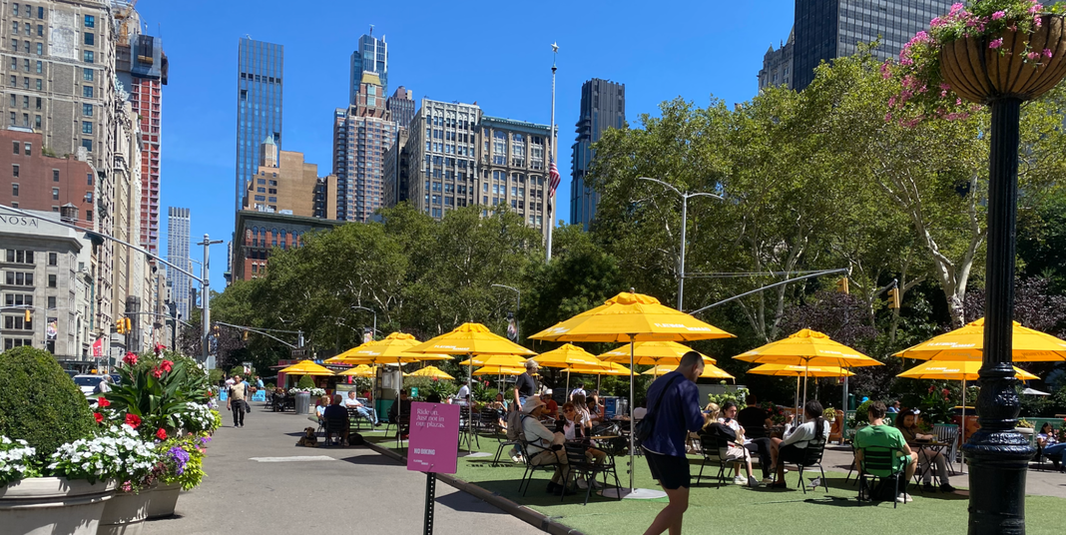 In New York, urban street life outside your studio apartment is crucial. It’s a vital source of social connection. New to the city, I went for many walks with my dog, Arlow, and discovered that each block has a specific personality: maybe funky, stuffy or infuriating (hello, Time's Square). Neighborhoods are expressed in their architecture, the green spaces, the types of shops and eateries which draw an ever-changing flow of pedestrian traffic. Covid brought the additional element of outdoor dining to the mix. Existing and struggling restaurants expanded into the street with outdoor dining options. Not only did these structures occupy more space but offered an expansion of the public place. They changed urban street life and how we responded to our cityscape. This bond between people and place, called topophilia, is formed through human perception and experience when we are exposed to places. As I write to you today, I want you to examine your own experience with topophilia. Topophilia is not confined to a single city. So as you read, and then go about your day, I encourage you to take a more active role in fostering your connection with your city. Every city has its own charm. Your involvement can make a significant difference in creating a more vibrant and successful street life. According to Yi-Fu Tuan (geographer and writer who popularized Topophilia) a place is a physical area that encourages “stopping, resting and becoming involved.” When I walk through a sidewalk cafe, even though I have not ordered an appetizer or a drink, I interact, even in passing, with restaurant workers and diners. I create meaning in a more complex way for myself, as well as the patrons and servers. My fleeting presence contributes to the general atmosphere of the outdoor cafe or bar. Remaining open to spontaneous conversations with people enjoying their meals in outdoor dining spaces can not only deepen your connection with your community, but also with your street; insights into what makes these spaces unique to where you are. Outdoor dining has also left us with diverse temporary structures that need to be creative to maximize space and to be welcoming and attractive for patrons and passersby. (Passersby may be converted into patrons by having positive experiences with the outdoor structures, which is also economically beneficial for your community!). As you walk through your city, think about how people spend time in these semi-improvised buildings and move around and through them. Or is this a case of place versus space? Commuters, taxis drivers and delivery trucks complain that outdoor dining sheds took over spaces for parking and servicing the city, and replaced them with public places--perhaps only for the benefit of the restaurants. Congestion builds. Horns honk. Some outdoor dining structures are abandoned, decay and fall apart. How do we find the right balance? In ‘The Creative City: Foundations of the Creative City’, Landry calls public spaces in cities ‘neutral territory’ and considers how they generate creative ideas. He argues that places where people feel simultaneously comfortable, stimulated and challenged can be a great resource. These kinds of spaces generate creativity and change. Sidewalk cafes now offer New Yorkers more time in “key locations for the public realm.” New York streets become our collective third place, offering the widest range of serendipitous, and perhaps unpredictable, interactions between many different types of people. Sidewalks are now liminal spaces between establishments that are defined by brick walls and glass windows to their more visually and physically open structures. This is part of what makes us love New York, if you’re looking at the city as a placemaker that is. Where our ‘first place’ is our studio apartment, our ‘second place’ is our work, and now our ‘third place’ may be re-imagined to include an expanded version of our favorite eateries. But these may only be there for a moment. Sometimes these structures go up and are torn down within the blink of an eye. Post Covid, restaurants petitioned for open space infrastructure (see my previous article ‘Concrete to Cafes: The Evolution of Public Space in NYC’). Let the experience of Topophilia inspire you and let that enthusiasm circulate to those around you. Look for opportunities to be involved in signing petitions, or in writing letters of appreciation to city officials who played a role in your city’s open street program or in outdoor dining structures that you see make a positive impact. Jeff Siegler, author of ‘Your City is Sick’ comments, “Cities are not outcome oriented, but process-driven. Even when there is a clear consensus on what people want, there is truly no way to achieve it if we continue working through the current process a municipality has in place.” Allow your topophilia to change the way in which you appreciate and interact with your surroundings, granting it license to spark creativity and become a part of the process itself. Grab your camera or smartphone and head out to capture the essence of your town or city. Take pictures that showcase the unique character of different neighborhoods, the people, the architecture, the green spaces, and of course, the street dining experiences. Share these images on social media using a dedicated hashtag for your city, allowing others to appreciate the beauty and diversity of your urban environment. Embrace topophilia and let it inspire you to be an advocate for your community's thriving urban spaces.
0 Comments
Leave a Reply. |
AuthorsArticles contributed by placemaking experts across the US Archives
July 2024
Categories |
PlacemakingUS
|
PlacemakingUS Newsletters
|





 RSS Feed
RSS Feed
